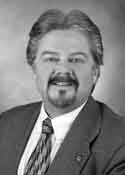 | Robb Rose is Director of Marketing Operations at Wesley Rehabilitation Hospital of Wichita. Robb is also a Respiratory Therapist, Boarded Disability Analyst and Adjunct Faculty for Wichita Sate University. He holds a Masters in Human Resources from Webster University. Robb serves on the American Lung Association Regional Council and the American Heart Association Board of Directors. Robb is married and has 2 children. He can be reached at (316) 729-9999 |
Health & Rehabilitation
2008-12-31 10:25:00
Nerve conduction studies & EMG
Answer: An Electromyogram (EMG) measures electrical activity of your muscles during rest and during work or contraction. A Nerve Conduction Study measures how well and how fast your nerves send the electrical signals to your muscles. In short an EMG measures muscle activity and a Nerve Conduction Study measures your nerves electrical activity. Both are inter-related, yet define different things for a better and more specific diagnosis. When both studies are to be done, the nerve conduction study is usually done prior to the EMG.
Nerve conduction studies take from approximately 15 minutes to an hour, depending on the area to be tested, such as a single arm vs. the entire side of ones body or more. In the study, several flat metal disc electrodes are placed on the skin. A shock emitting electrode is placed over the nerve to be studies, and a recording electrode is placed over the muscle that is supplied by the nerve. A very low voltage electrical current is used to create several brief pulses that are measured for speed or conduction velocity. This is how fast the electrical current traveled, and compared to what is the medical standard for normal. Each pulse lasts less than a millisecond. Patients can experience a brief tingling, twitching, burning sensation, or even a nervousness, that subsides fairly quickly.
Electromyogram studies involve the insertion of very small needles (i.e. similar to acupuncture needles) into specific muscles to be studied. Electorodes are attached to the needles, and electrical measurements are monitored at rest and at work (contraction of the muscle). The needles with electrodes are moved to different positions in the muscles being studied. An EMG takes approximately 30-60 minutes to do. Patients may experience a short, sharp pain as the needles are inserted; and even a tingling or tenderness at the location of the muscle testing.
Because of both studies using electrical current (i.e. very low voltage), and the EMG study using small needles, some patients can become anxious just at the suggestion of the study. The actual time length of the studies is pretty short, with both being less than an hour generally and that includes set up and completion. Actual pain thresholds for most patients is pretty minimal, and compared to the information that the studies provide, the benefits far exceed the short period of discomfort. The tests, when conducted in expert hands, greatly decreases the discomfort as well.
Having these tests done at an Accredited Rehab Facility and/or Hospital or Clinic, by an approved technologist under the supervision of a physician specialist such as a Physiatrist (i.e. Physical Medicine Rehab Specialty Physician), or Occupational Medicine Physician greatly improves the outcomes. The testing can be done as an outpatient or inpatient, can diagnosis numerous neuromuscular disease states that can be treated once diagnosed. Friends, family and myself have been the patient for both of these type of studies and they proved to be well tolerated with beneficial useful outcomes for treatment. Once the studies are conducted, analyzed, and confirmed the doors for beneficial and appropriate Rehab Therapies such as PT, and OT can begin.


